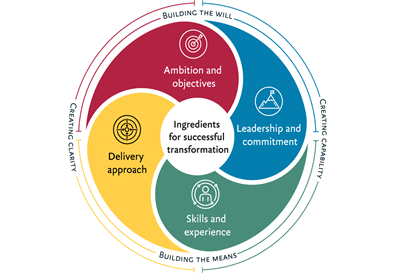Delivering wall-to-wall enterprise resource planning (ERP) platforms, driving business process changes to comply with regulations, and launching new operational capability could all have global reach. As such, when you need consistency and worldwide take-up – which global organizations often do – the challenges multiply.
In our experience, there are three factors – money, sponsorship and fit – that you must address upfront. Take them lightly and you’re in for a long haul.
Where’s the funding for your global program?
Many organizations have issues around the right funding model for their global programs. Regional businesses with demanding profit and loss targets sometimes resist investing in global initiatives. A region with its own priority programs, for example, may believe these outweigh the global program, especially if the region’s budget is constrained.
Most companies face this tug of war between central and regional funding. It leads to the question, who should pay for large-scale global programs – the central office or the regions under it? Central office may well decide to fund the program, which leads to another question: who’s in charge of making sure benefits to the regions also satisfy the global case?
To some extent, this depends on the program itself. Is it mandated by law? Are there economies to be gained through global adoption? Is global capability and consistency part of the strategic value proposition for the organization? Answer ‘yes’ to any of these and you strengthen the case for centralized funding.
In practice, though, it’s often more nuanced, with budget and benefits realization moving between the central and regional structures. For example, we work with a global consumer products business. It funds development of global capability templates centrally. It expects the regions to bear the cost to deploy these templates and to drive benefits capture. But once deployed, the central office also operates the capability via a global budget to unlock economies of scale in centralized support. So the funding model follows the operational focus.
What’s clear, however, is that your funding model for global program must be determined and positioned upfront.
Making provision for funding, unlocking the budgets and allocating accountability for benefits capture are vital.
Who is leading your global program?
Linked to the money is sponsorship. If an initiative starts as a global program, it can be set up and governed centrally. That is, if organizational accountabilities and decision-making processes between the central and the regional offices are well understood. But an initiative often starts in a specific locality; it achieves some success and traction before it’s considered globally. The decision to extend these types of initiatives prompts certain questions. Should executive sponsorship remain local, with those who hold the experience of execution? Or should the knowledge and sponsorship transfer to the center?
The size of the organization has a bearing here. If there are a handful of operating companies that need coordinated sponsorship around an initiative, then bespoke governance arrangements and clear roles and responsibilities may be enough. If the organization operates in numerous countries across various regions, a more centralized program structure and execution capability is likely needed.
We worked with a global products company that wanted to embed a sales and marketing analytics capability in more than 80 markets worldwide. Although much of the analytics engine was common, each market had its own data sources and processes governing how it worked with customers, which needed customization. To get the right balance of global and regional ownership, we set up a global steering group with strong regional market representation and a common approach to deployment in each market. Deployment was driven by a regional project lead, with support from a global project manager to provide expertise and knowledge transfer.
Clear sponsorship and the right partnership between global and regional leadership really do matter. You should identify and address these issues upfront to get the resources you need for your global programs.
Does your global program fit your local operating models?
Global programs need to take into account the operating model they will dock into, given that operating models may differ from one region to another. Many factors will shape local operations – local customs, third-party arrangements and customer preferences, for example. So the way a program is delivered in a particular region or country may need to adjust. It might be that the organization has a global operating model design. Even so, our experience is that local variation comes into play, and often for good reason. It’s important, therefore, that you consider these variations.
We worked with a leading global marketing services company that wanted a consistent procurement function worldwide. It became clear that its two largest regions had different visions of the target procurement vision, operating model and desired technical platform. We proposed the program take a step back. This was to independently assess the reasons for the divergence, understand what lay behind those and see if common ground could be found.
In this case, regional stakeholders were able to align and unify around a single vision for the procurement function. This then enabled the program to proceed to global platform selection and subsequent implementation.
Local operating models must be taken into account when driving out global solutions. If the existence of local variation is not recognized, and overtly addressed, the likely outcome is that the global solution is not adopted and hence benefits cannot be realized.
Get your global program off to a good start
Global programs are tricky. They demand strong executive sponsorship combined with a clear vision and benefits case. Yet they must consider regional agendas, drivers and operating realities, too. When organizations fail to consider these elements upfront, the consequences are execution difficulties, turf wars and wasted resources. Of course, simply considering these factors won’t guarantee successful outcomes, but it will improve your chances of getting there.












